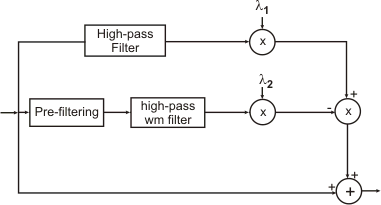| Image Sharpening(continued)
Because of the weight coefficients in Eq. (5.8.8), for each position of the moving window, the output is proportional to the difference between the center pixel and the smallest pixel around the center pixel. Thus, the filter output takes relatively large values for prominent edges in an image, and small values in regions that are fairly smooth, being zero only in regions that have a constant gray level.
Although this filter can effectively extract the edges contained in an image, the effect that this filtering operation has over negative-slope is different from that obtained for positive-Slope edges .
Note :[ A change from a gray level to a lower gray level is referred to as a negative-slope edge, whereas a change from a gray level to a higher gray level is referred to as a positive-slop edge.]
Since the filer output is proportional to the difference between the center pixel and the small pixel around the center, for negative-slope edges, the center pixel small values producing small values at the filter output. Moreover, the filter output is zero if the smallest pixel around the center pixel and the center pixel have the same values.
This implies that negative-slope edges are not extracted in the same way as positive-slope edges. To overcome this limitation the basic image sharpening structure shown in Figure (5.33) must be modified such that positive-slope edges as well as negative-slope edges are highlighted in the same proportion. A simple way to accomplish that is: (a) extract the positive-slope edges, and then filter the preprocessed image with the filter described above; (c) combine appropriately the original image, the filtered version of the original image, and the filtered version of the preprocessed image to form the sharpened image.
 |
Thus both positive-slope edges and negative-slope are equally highlighted. This procedure is illustrated in Figure (5.34), where the top branch extracts the positive-slope edges and the middle branch extracts the negative-slope edges. In order to understand the effects of edge sharpening, a row of a test image is plotted in Figure (5.35) together with a row of the sharpened image when only the positive-slope edges are highlighted, Figure (5.35), only the negative-slope edges are highlighted, Figure (5.35), and both positive-slope and negative-slope edges are jointly highlighted, Figure (5.35)
In Figure (5.34).  and and  are tuning parameters that control the amount of sharpness desired in the positive-slope direction and in the negative-slope direction, respectively. The values of are tuning parameters that control the amount of sharpness desired in the positive-slope direction and in the negative-slope direction, respectively. The values of  and and  are generally selected to be equal. The output of the prefiltering operation is defined as are generally selected to be equal. The output of the prefiltering operation is defined as
 |
(5.34) |
with M equal to the maximum pixel value of the original image. This prefiltering operation can be thought of as a flipping and a shifting operation of the values of the original image such that the negative-slope edges are converted in positive-slope edges. Since the original image and the pre-filtered image are filtered by the same WM filter, the positive-slope edges and negative-slopes edges are sharpened in the same way.
|